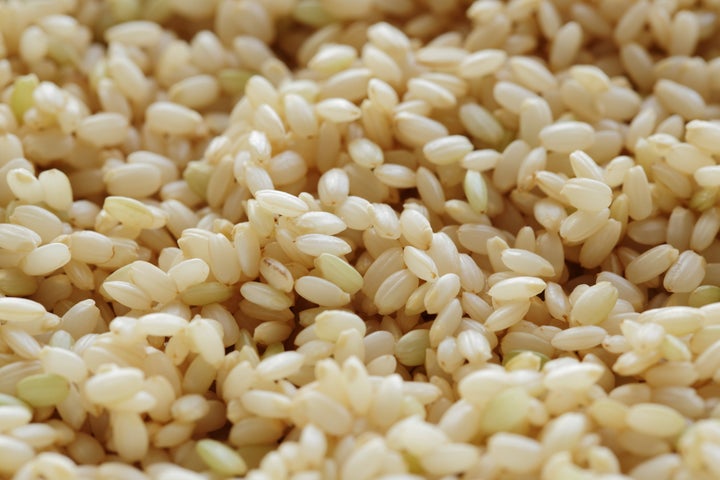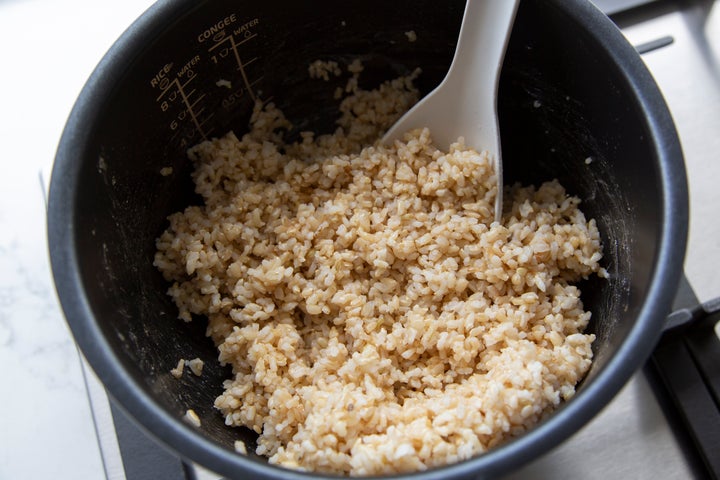
If you’re one of the many people who doesn’t like brown rice, you might be missing out on enjoying a nutritious food because you’ve skipped a step in the kitchen. Making tender, nutty-tasting brown rice takes one little trick that costs zero pennies.
The step that is so important, and often overlooked, is simple: just take the pan off the heat and let the cooked rice sit, covered, for about 10 minutes to finish steaming. This also applies to other whole grains, like farro, wheat berries and sorghum.
I wanted to find out the science behind what’s going on in that pot, so I asked Cameron Jacobs of the USA Rice Federation. “Brown rice has the nutritious and hearty bran layer surrounding the endosperm intact. The act of allowing it to sit covered allows the brown rice kernels to absorb additional moisture from all the steam and leaves the consumer with an optimal mouthfeel for brown rice and a much less chewy grain than if you were to eat directly after all the water was absorbed.”
I also asked Harold McGee, author of the seminal book ”On Food & Cooking: The Science & Lore of the Kitchen,” and a food chemistry expert. “It takes time for the absorbed water to become distributed evenly throughout the grains and hydrate the starch at the centre; and serving the hot rice immediately will cause it to evaporate away some near-surface moisture as visible steam, leaving the bran a little drier and firmer. I actually don’t mind that contrast in texture, but the 5-10 minute rest does give you a more evenly cooked pot.”
The Steps To Cooking Perfect Brown Rice
Rinse
First, you do need to rinse the rice. All grains rub against each other during shipping, scraping fine particles loose. To remove it, simply place your rice in a bowl, cover with cool water by an inch or two, and swish the rice around with your hands. Pour off the water and drain in a wire mesh strainer.
Soaking (not a requirement)
Because brown rice is coated with a bran layer, where all that sturdy fibre resides, brown rice and whole grains can benefit from soaking overnight, or even for an hour or so. If you’re in a hurry and didn’t plan ahead, you can skip it. If you’ve heard that whole grains should be soaked to remove phytates, which might prevent absorption of some nutrients, don’t worry.
According to registered dietician Kelly LeBlanc, “From a nutritional standpoint, the concern around phytates and mineral absorption seems to be overblown. Regularly eating a diet high in phytates may limit this ‘anti-nutrient’ effect, as shown in a 2015 study in the Journal of Nutrition. Since phytates are found naturally in plants, it’s not surprising to learn that they may also have some antioxidant and anti-cancer properties. In my own personal kitchen, I’ll try to give long-cooking grains like sorghum, barley, and wheat berries a soak to help reduce their cooking time. But if I happen to forget, it’s not something I lose sleep over – my meals are still yummy.”

The best rice-cooking methods
The absorption method looks like this: Simply boil 2 cups water, add 1 cup rice, return to a boil, then reduce the heat to low, set a timer for 35 minutes and cook, covered, until the water is absorbed. Then let it stand for 10 minutes.
If you prefer “pasta-style” cooking, you bring a pot of water to a boil, add the grain and boil until tender, then drain. Then, be sure to return the hot grain to the pot, cover and let stand for 10 minutes.
If you have a standard rice cooker, it will turn itself off when the water has absorbed, and you should give it 10 minutes to finish steaming then. Multifunction rice cookers, like Zojirushi, have built-in soaking and steaming to the program for brown rice.
In an Instant Pot or pressure cooker, use a 1:1 ratio of brown rice to water, and let the pot release naturally, for a final steam.
Why is brown rice worth the effort?
If you’re still on the fence about cooking brown rice instead of white, just know that its rep as a “health food” is well-deserved.
According to Emily Ho, a distinguished professor of nutrition at the College of Health at Oregon State University, “Because it still has the hull, bran layer and germ intact compared to processed white rice, it is packed full of nutrients like B vitamins, magnesium, potassium and iron. It also is a great source of dietary fibre that can help your gut health. Consumption of brown rice is associated with lower risk of type 2 diabetes compared to intake of white rice, and lowering of blood glucose.”
What a difference a few minutes can make!